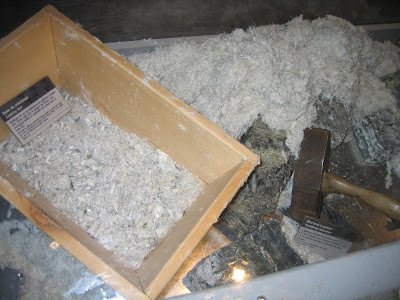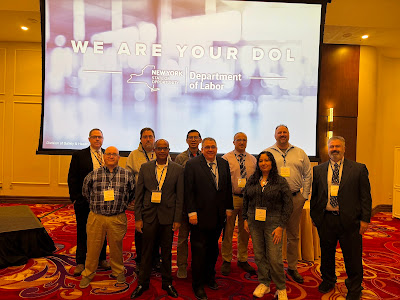Future Environment Designs, Inc. (FEDTC) was honored to be invited to the Asbestos Disease Awareness Organization’s (ADAO's) 20th Annual Asbestos Awareness and Prevention Conference (AAPC 2025), held at the historic Mount Sinai Hospital (fun fact: Angelo Garcia, III was born there) in New York City. The conference was an extraordinary success—an inspiring gathering that honored frontline heroes, scientists, advocates, and policymakers who continue to advance asbestos science, prevention, and justice. Their work, rooted in Dr. Irving Selikoff’s groundbreaking contributions, continues to guide ADAO's mission and strengthen its resolve.
 |
| Candlelight Vigil at 9/11 Memorial |
This milestone year—two decades of ADAO’s leadership in education, advocacy, and community building—brought together a global network of experts and survivors committed to ending asbestos exposure and saving lives. The conference shared life-saving information, reached new audiences, and deepened the collaborative spirit that has defined ADAO since its founding.
Linda Reinstein, Co-Founder & President of ADAO, declared: "On behalf of the Asbestos Disease Awareness Organization, we extend our heartfelt gratitude to every attendee, speaker, honoree, presenter, volunteer, sponsor, and steadfast supporter who made this historic event possible."
A Legacy Honored: Dr. Irving Selikoff’s Enduring Impact
This year’s theme, “Building on Dr. Selikoff’s Legacy in Asbestos Science, Prevention & Justice,” paid tribute to the physician whose pioneering work exposed the dangers of asbestos and reshaped occupational health policy worldwide. To commemorate this legacy, the conference proudly unveiled the 10th poster in "BADGES: A Memorial Tribute to Asbestos Workers," created by award-winning documentary photographer Earl Dotter. Titled “Science. Prevention. Justice.”, the tribute honors Dr. Selikoff’s transformative influence and reaffirms everyone's commitment to continuing the critical work he began.
 |
| BADGES: A Memorial Tribute to Asbestos Workers |
The program also included a moving remembrance of September 11, honoring those who lost their lives to asbestos-related diseases following that tragic day — a solemn reminder of the long-term consequences of toxic exposures and the urgency of prevention.
Celebrating Excellence: Honoring Advocates, Researchers & Community Leaders
ADAO’s annual awards ceremony recognized remarkable individuals and organizations whose contributions embody the spirit of their mission:
Alan Reinstein Award — John Feal, for his tireless advocacy for 9/11 first responders and dedication to securing justice for survivors.
Warren Zevon “Keep Me in Your Heart” Award — Danny Goldberg, for keeping public attention on asbestos victims through meaningful storytelling.
Saturday Keynote Address — The Honorable Gale Brewer, NYC Council Member for the 6th District, whose leadership continues to advance public health protections.
The Dr. Irving Selikoff Awards - Presented to three exemplary leaders in asbestos research and clinical innovation:
 |
| Dr. Claudia Henschke & Dr. David Yankelevitz |
Their groundbreaking contributions in detection, screening, and treatment continue to offer hope to patients and families.
Additional honors included:
- Tribute of Hope Award — Greg Russell
- Tribute of Unity Awards — Uniformed Firefighters Association & Uniformed Fire Officers Association
- Tribute of Inspiration Award — United Federation of Teachers
ADAO also paid tribute to Karen Grant, who was posthumously honored with the Alan Reinstein Award. Her powerful recorded message—shared courageously before her passing—left an indelible mark on all who heard her story.
 |
| Karen Grant |
A Robust Academic Program: From Selikoff’s Vision to Today’s Innovations
Saturday’s academic program featured five comprehensive sessions, each tracing the evolution of asbestos science and policy from 1964 to the present:
1. From Then to Now – Selikoff’s Vision and Our Journey Forward - A sweeping overview of six decades of scientific discovery, regulatory shifts, and advocacy milestones.
2. Diagnosing and Treating Asbestos-Related Diseases - Experts from Mount Sinai and Memorial Sloan Kettering unveiled promising new treatment options and clinical trial advances that provide real hope for patients.
 |
| Andrea Wolf, MD, MPH, Director, NY Mesothelioma Program Professor, The Icahn School of Medicine at Mount Sinai |
3. Prevention Is the Cure – Strategies for Exposure Reduction - Discussions ranged from 9/11 firefighter screenings to wildfire toxicity in Lahaina and Los Angeles, while also highlighting digital tools and innovative prevention strategies presented by Chris Carberg and Linda Reinstein.
 |
| David Prezant, MD, Chief Medical Officer for the FDNY |
4. Dr. Irving Selikoff, Paul Brodeur, and Beyond - A critical examination of scientific suppression, transparency, and Paul Brodeur’s groundbreaking 1970 New Yorker exposé.
5. Asbestos and the Law - A deep dive into the role of litigation in driving corporate accountability, protecting public health, and enabling justice for victims.
Nearly 40 distinguished experts from four countries enriched these discussions, making this one of ADAO’s most comprehensive programs to date. ADAO's 158-page conference program, available online, reflects the depth, diversity, and rigor of this year’s content.
Global Access, Free for All
In keeping with ADAO’s commitment to health equity, this year’s conference will be accessible online at no cost. Access to life-saving public health information should never be restricted—and we remain steadfast in ensuring that education reaches all who need it.
Conference session videos will be available on the ADAO YouTube Channel, allowing global audiences to learn from and engage with this important content.
Building Momentum for Change: ARBAN 2025
The program contains letters of support — not only for the conference but also for the Alan Reinstein Ban Asbestos Now (ARBAN) Act. Special thanks were given to:
- Senator Jeff Merkley
- Representative Suzanne Bonamici
- Representative Don Bacon
- International Association of Fire Fighters (IAFF)
- Collegium Ramazzini
- Olin Corporation
Their continued support demonstrates the growing national momentum toward comprehensive asbestos reform and the critical importance of achieving a long-overdue ban.
ADAO Donors and Sponsors
Donors and sponsors of the conference included:
- Platinum: Dean Omar Branham Shirley, LLP; Simmons Hanly Conroy, LLP
- Gold: The Gori Law Firm; Motley Rice LLC
- Silver: Early, Lucarelli, Sweeney & Meisenkothen
Linda Reinstein said: "Your generous support ensures that ADAO’s education, advocacy, and community outreach efforts remain free and accessible to the public. Your partnership fuels our mission to create a world free from asbestos exposure."
Looking Ahead: Renewed Strength, Shared Purpose
We would again like to thank Linda Reinstein and ADAO for inviting us and the members of the Professional Abatement Contractors of New York (PACNY) to the conference. For someone who has attended our share of conferences, it truly was educational and eye-opening. We have shared our experience, the hope, and the information we learned from the conference in our classes since September.
As Linda Reinstein said: "The path toward an asbestos-free future is long, but with your support, your voices, and your unwavering dedication, we are closer than ever."
Join Us in Advancing Science, Prevention, and Justice
Though the 20th Annual Asbestos Awareness and Prevention Conference has ended, the work does not end there. Your voice, your engagement, and your advocacy are essential in driving the policy changes and public health protections our communities urgently need.
Stay connected with ADAO, share their resources, contact your lawmakers about ARBAN, and help us push for a future where no family suffers from preventable asbestos exposure. Together, we can finish the work Dr. Selikoff began.
Related Posts:



































